Dune: Part Two is more than a mere sequel. It’s a continuation, culmination, and ultimately a fantastic elevation of everything you already loved about director Denis Villeneuve’s 2021 film Dune: Part One. That film ended with Paul Atreides (Timothée Chalamet) embracing a new way of life after almost everyone he loved was massacred. Here, after a brief interlude, things pick up right where they left off and weave a sweeping, cautionary tale of a young man burdened by destiny and how he’ll act to fulfill it. The film is dense and complex but also majestic and engaging on a level the first film merely touched upon.
That’s saying something too because Dune: Part One—which won six well-deserved Oscars for technical achievement—was itself a remarkable accomplishment. This time, that level of skill is not just back, it might be better. Dune: Part Two looks stunning, filled with shots you’d be glad to hang on your wall. The attention to detail in every frame is masterful, with costumes and props that could be works of art on their own. You feel every sound and note of music in your bones as well as your heart. It’s also quite weird, fully embracing author Frank Herbert’s voice and originality. Much like the first film, the script by Villeneuve and Jon Spaihts is crafted in such a way that while every name or concept may not stick, the most crucial parts of the story are easy enough to understand. So even if you don’t know your Kwisatz Haderach from your Sietch Tabr, you get enough to enjoy it.
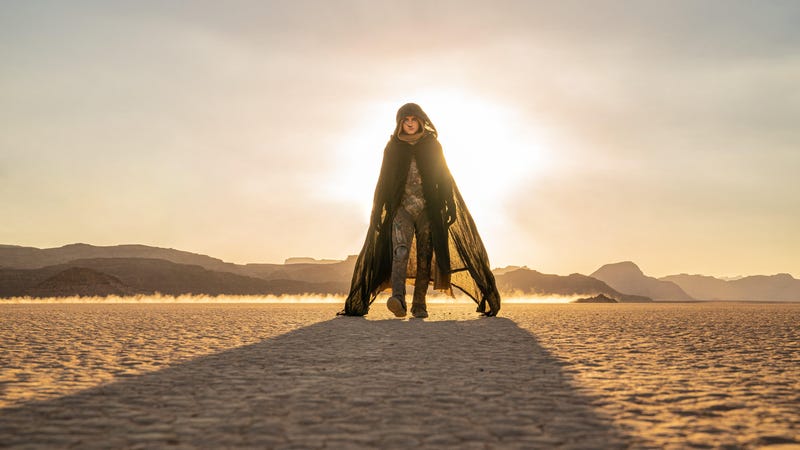
But, again, you can say most of that about the first film. What distinguishes Dune: Part Two from its predecessor are the more complete and layered performances and characterizations, the escalation of tension via editing, and new additions to the cast elevating already exciting material. All of which starts with Paul Atreides.
This is Paul’s story. The first film was his story too—but now that he’s broken, lost, and in a whole new culture, Villeneuve fully focuses on the character’s growth, humility, and burgeoning purpose. Take a snapshot of Chalamet in the film’s first scene versus its last and it would look like two different people. To earn that, Part Two traces Paul’s accomplishments, decisions, and ever-changing mental state beautifully, anchored by an award-worthy lead performance by the actor. Anyone who thinks of Chalamet as a generally cute and unthreatening on-screen presence will have those preconceptions blow up in a big, big way with Dune: Part Two. He goes dark, and it’s fantastic.
As Paul slowly starts to realize he may be this messiah the Fremen of Arrakis have been waiting for, he’s constantly checked by the rising romance he has with Chani, played by Zendaya. Dune: Part Two considerably beefs up her role, not just from the first movie but the original novel too, giving Paul both a worthy partner as well as a formidable voice to challenge his own. Chani takes no shit, speaks her mind, and is never scared to be defiant, even in the scariest of circumstances. Zendaya’s intense, confident performance creates a character with an equally interesting and important arc in the film as Paul’s. One that embodies many of the film’s most noteworthy themes about religion, prophecy, and loyalty.
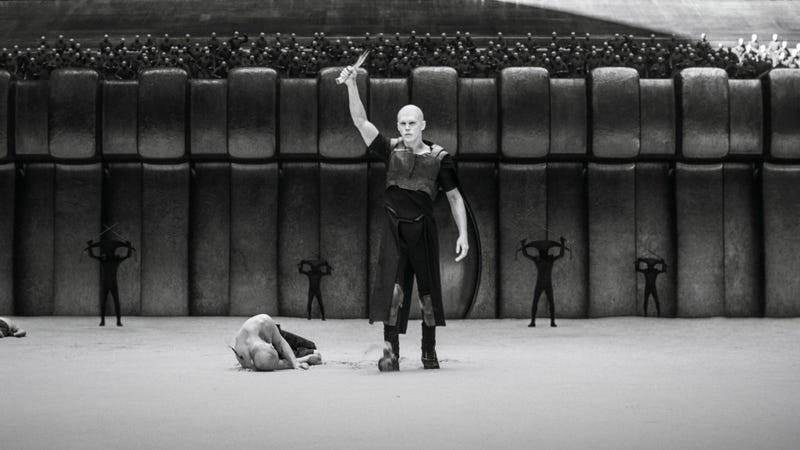
And while Dune: Part Two focuses mostly on Paul’s side of the story, the villains are much more prevalent and entertaining this time around. Part One saw the Harkonnens, led by the Baron (Stellan Starsgård), massacre the entire Atreides family, or so they thought. In the sequel, we spent more time with not just him, but his nephews Rabban (Dave Bautista) and Feyd-Rautha, played by Austin Butler. Butler’s Feyd-Rautha is a new addition and he gives as chilling a sci-fi performance as we’ve seen in some time. Rautha is clearly being set up as a force capable of dethroning Paul and though we don’t spend as much time with him, every time we do, it’s terrifying and intense. Through Rautha, and Butler’s interpretation of him, we see a whole other perspective on this world and almost a mirror of what Paul could become.
The Harkonnen genocide of the Atreides was done on behalf of the Emperor, a character absent from the first film, but brought to life here by the one and only Christopher Walken. He’s often joined by his daughter, Princess Irulan (Florence Pugh), who acts as a go-between for all the characters and partial narrator. As per Herbert’s novel, neither gets a ton to do in this movie but each actor still has enough presence that their characters fit effortlessly into the world, exhibiting presence and authority befitting of royalty. Every time they appear, you want to see more of them.
Villeneuve is able to simultaneously bolster Paul and the Harkonnens by finding an almost superhuman balance in editing between the two sides. Early sections of the movie are long and consistent. Then, as the action continues to rise, the parallel editing increases in speed. Dune: Part Two starts with over an hour of just Paul and the Fremen on the bright, sandy surface of Arrakis. There’s no break in the story. No cutaways. We get a nice, long, noteworthy chunk that could be an entire movie on its own. Only later does the film completely shift gears to the Harkonnens, spending a shorter but still noticeably long (about a half-hour) uninterrupted section with them. The transition is so jarring it almost feels like a sequel within a sequel. As the film progresses from there, the handoff between scenes gets shorter and shorter as the two stories start to blend and, eventually, explode in a briskly paced, multi-faceted third act. The deliberate increase in pacing means that Dune: Part Two, even at almost three hours, is never ever boring.
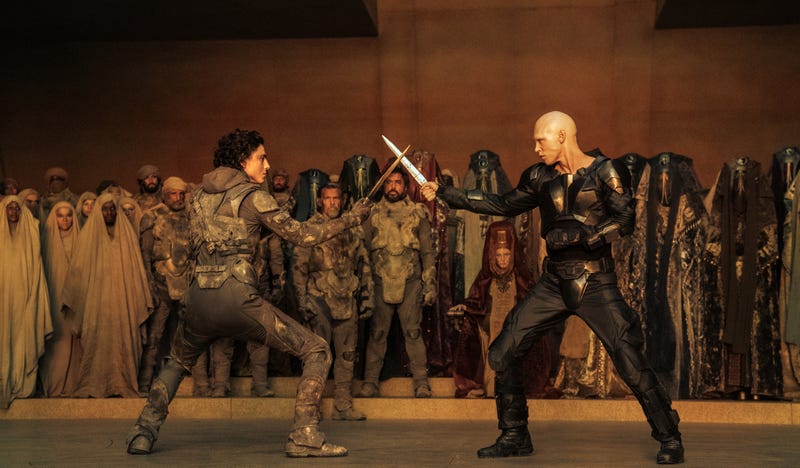
So we’ve established Dune: Part Two looks great, sounds great, has wonderful performances, and an exciting pace. Is that it? Nope. It’s fun as hell too. Dune: Part One certainly had its share of thrilling, action-packed set pieces, but they somehow pale in comparison to the ones in Part Two. From the first time Paul rides a sandworm, to an epic showcase for Feyd-Rautha, to a full-fledged war with Lord of the Rings scale, and the personal, poetic, powerful final showdown, the action scenes provide a cathartic blend of anticipation, excitement, and payoff. You feel like you are on that sandworm, in a close-quarters knife fight, or flying through the air. Villeneuve makes sure, no matter what the scale, that his action has energy but is also easy to follow, which adds to the enjoyment. Scenes of Paul falling through sand for example are completely chaotic and blurry. And yet, somehow, we can still see and follow it all perfectly. Plus, the set pieces are spread out just enough to add to the film’s pacing, keeping the ebb and flow of it engaging throughout.
Probably the most challenging thing about Dune: Part Two is the story of Paul’s mom, Lady Jessica, played by Rebecca Ferguson. Following Herbert’s lead, the film quickly sends Jessica on her own journey. One that’s crucial both to the all-important lore of this story and the overall world. However, Jessica’s story is by far the least accessible in the film, simply because she doesn’t adhere to the usual mythology or the rules of reality. She sees the past, the future, constantly talks to her unborn baby, and is rarely easy to get a read on. It’s a lot. And still, through Villeneuve’s expert direction and writing, everything that feels weird and awkward about her character and story ends up adding so much to the decisions Paul, Chani, and the rest make in the end. So while it at first might seem as if Lady Jessica is a liability to the film, you have to trust Villeneuve that the tiny speedbumps are necessary and ultimately beneficial.
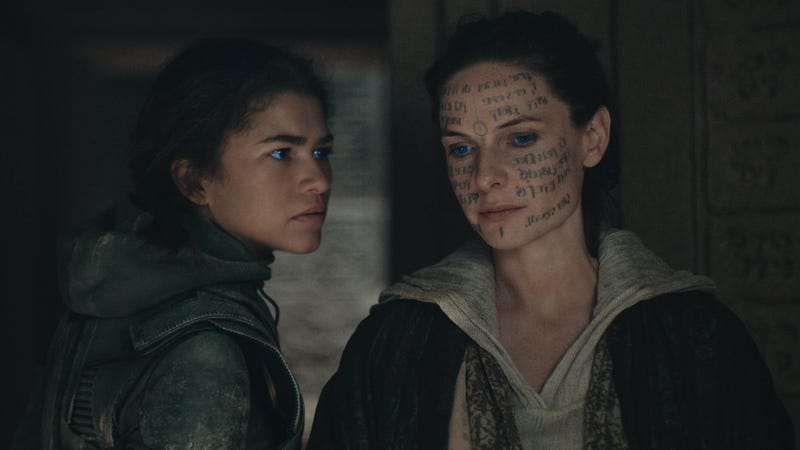
That’s what it all comes down to. To be a great director, you must have a vision, and Denis Villeneuve has vision to spare. In deciding to adapt Frank Herbert’s seemingly unadaptable book Dune, that vision was an ambitious gamble to split it into two halves, without a guarantee that the second part would ever be made. Many probably thought it would never happen. But, in Villeneuve we trust. He turned Part One into an award-winning hit and now Part Two completes, elevates, and integrates that already classic movie into something new and wonderful.
So if you liked the first Dune and were eager to see the story play out in a way that enhances the original, Dune: Part Two is all that and then some. It’s an excellent character piece told on a grand scale with all the action and visuals you’re craving. Stars like Chalamet and Zendaya shine, while new characters played by the likes of Butler and Pugh elevate everything around them. In keeping the story close to the original novel, Villeneuve does end the film rather abruptly, once again leaving us wanting more. But even if the film wrapped up in a bow, Dune: Part Two is so good, we’d want more regardless. It’s the price we pay for the privilege of watching the work of a seminal filmmaker who has just completed a definitive sci-fi saga for the ages.
Dune: Part Two opens March 1.
This story originally appeared on io9.
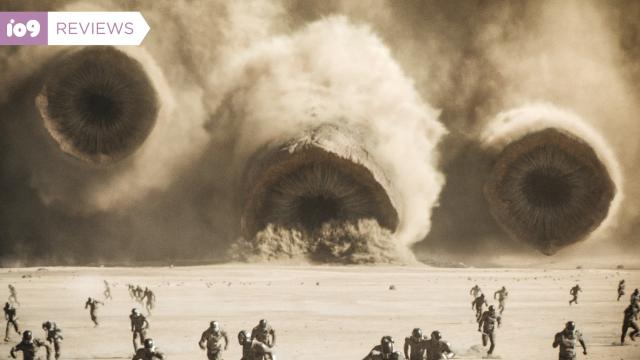
Leave a Reply